Author: Grégoire Chéron
The Maxi Edmond de Rothschild takes on the Jules Verne Trophy
Having cast off from Lorient in the early hours of this Sunday morning, the Maxi Edmond de Rothschild crossed the start line off the island of Ushant at 13h 9 min 30s UTC in her attempt to secure the Jules Verne Trophy. At the helm of the 32-metre giant, Charles Caudrelier, Franck Cammas and their four crew are taking on the prestigious round the world race against the clock. The aim: to beat the record of 40 days, 23 hours and 30 minutes set in 2017 by Francis Joyon and the men of IDEC. To achieve this, Gitana Team will have to make it back to Brest and the Le Créac’h lighthouse before 25 March 2023 at 12h 38min 59s UTC. Though rather unique, the weather window on offer to the Maxi Edmond de Rothschild is certainly worth a go, as there might well be a series of great opportunities for the five-arrow crew to snap up along the way.
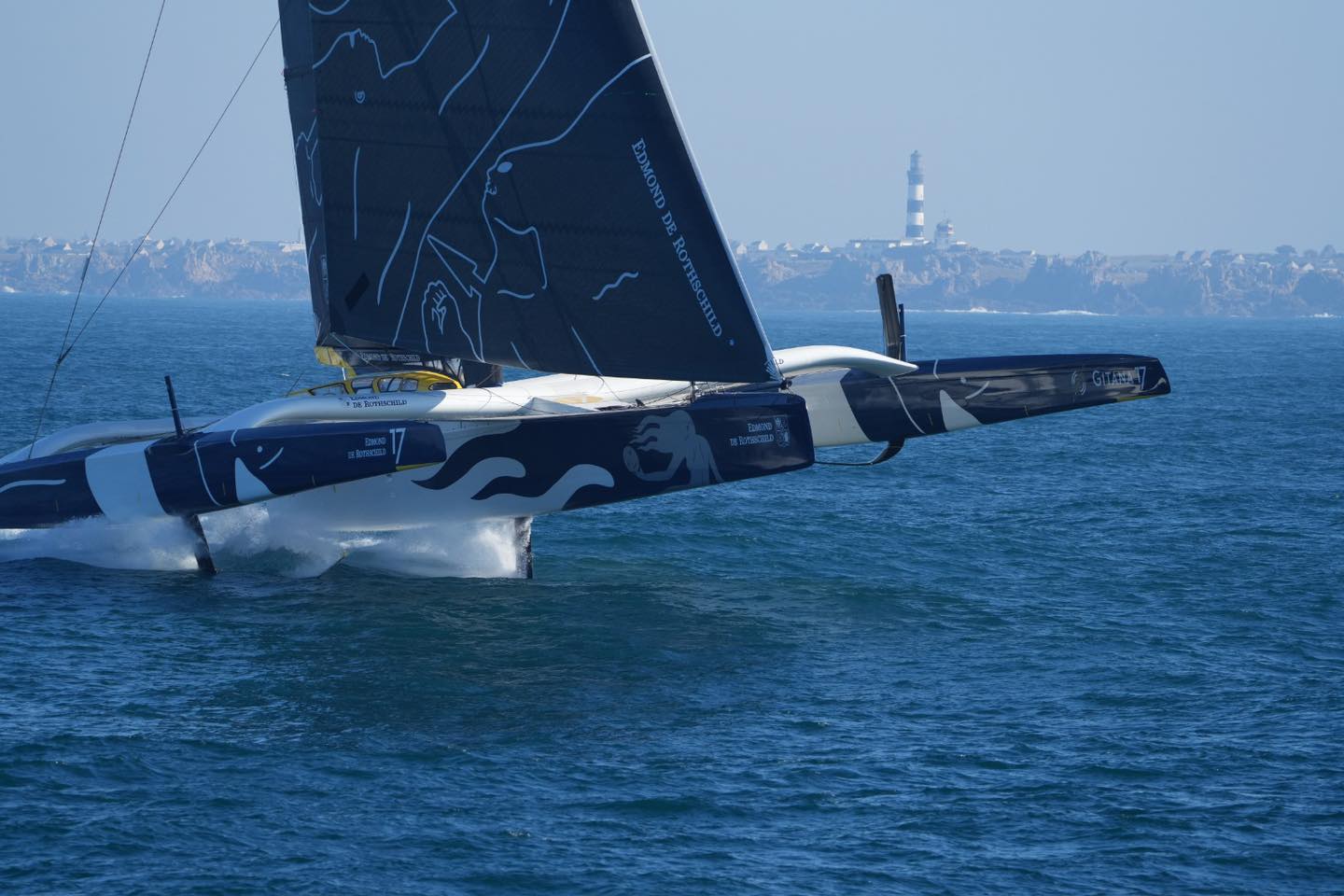
A far from standard weather window
Since Friday morning, the skippers of the Maxi Edmond de Rothschild and their router, Marcel van Triest, have been eyeing up a serious opportunity to finally get things underway in their sprint around the planet. However, from one grib file to the next, a series of discrepancies have made a tough choice even harder for the weather cell. Ultimately, true to the team’s philosophy of being bold and committed, early this Sunday afternoon the large flying trimaran fitted out by Ariane and Benjamin de Rothschild set sail on this iconic record of offshore racing.
Like Charles Caudrelier, all the members of Gitana Team freely admit that “the weather window is rather atypical,” a choice that the recent winner of the Route du Rhum-Destination Guadeloupe explains in more depth: “though we have a very precise idea of what may happen in the North Atlantic, the same cannot really be said in the South Atlantic. A low pressure system to the south of Brazil is a little uncertain according to the weather models.”In short, the team will have to locate “a bolt hole”, says Morgan Lagravière and “have a bit of luck with the sequence of weather systems,” continues Franck Cammas. However, the first few days at sea have been well identified with “upwind conditions to start and a front to hunt down tomorrow,”explains Erwan Israël. If the weather sequence subsequently proves less favourable, the crew reserves the right to turn back level with the Canaries in a bid to hunt down a better launchpad from the tip of Brittany.
Focused, determined and particularly enthusiastic, the six crew on the Maxi Edmond de Rothschild have set sail on their first attempt of the year, the third in all for the Verdier design following two aborted campaigns in 2020 and 2021. The latter came to an end after 12 days of racing at the entrance to the Southern Ocean, with the team ahead of the record having just secured the best ever time to the Agulhas Cape. Though setting sail in mid-February might appear quite late in the season, some has set off even later in the day, including Sport-Elec (Olivier de Kersauzon, on 8 March 1997) and Orange II (Bruno Peyron, on 2 March 2002).
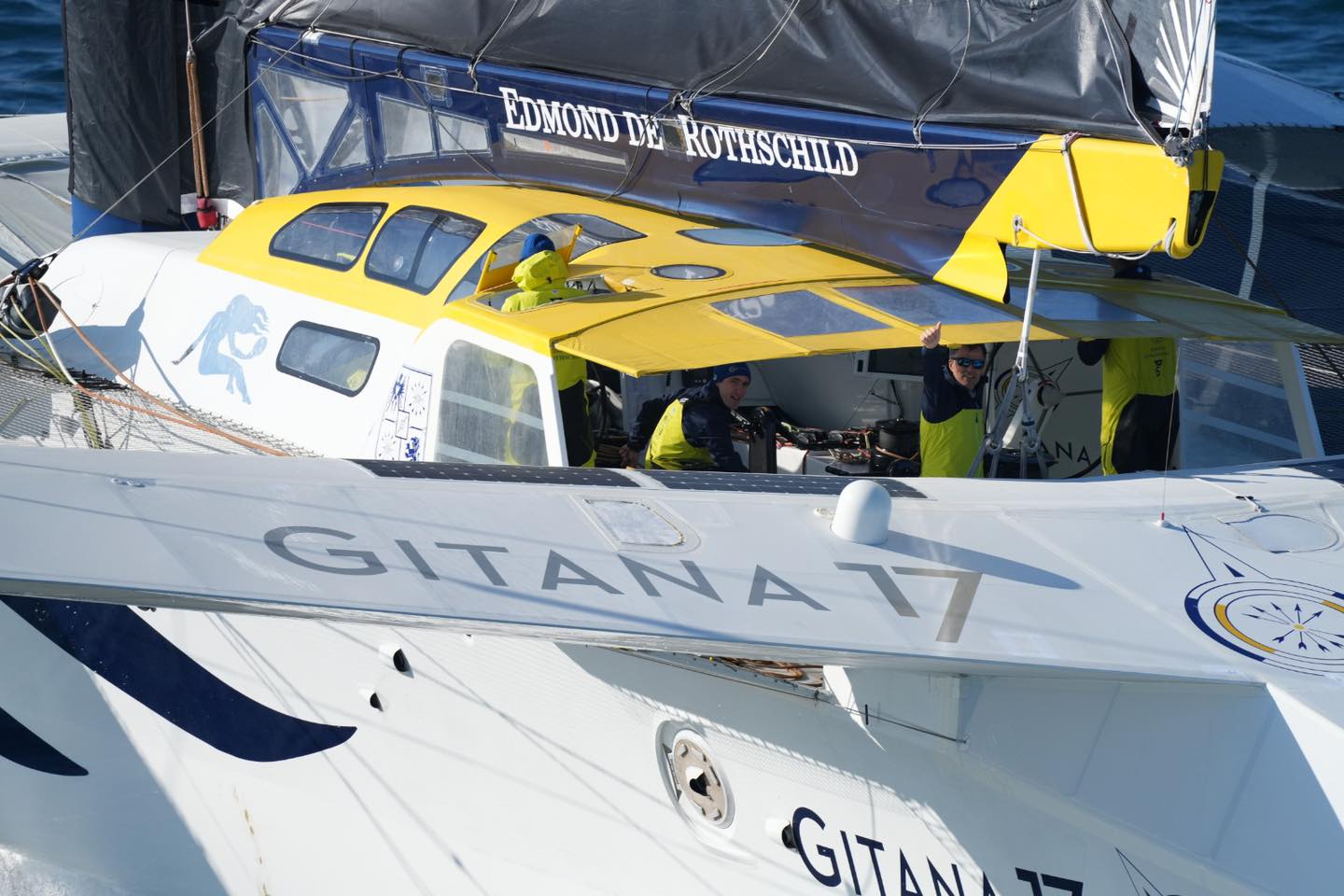
Charles Caudrelier, Franck Cammas and their crew now have their eyes glued to the upcoming waypoints, particularly one offshore of South Africa. “We need to have a lead of at least 24 hours over Francis Joyon’s passage time at the Cape of Good Hope (12 days, 19 hours),” stresses Charles. As a result, the team has a set of well identified goals and the race against the clock is most definitely on!
Quotes of the crew:
Charles Caudrelier: “It’s a fairly atypical weather window, but we’re getting to the end of standby and we’re keen to give it a go, especially with the grib files indicating some good passage times yesterday evening. Though we have a very precise idea of what may happen in the North Atlantic, the same cannot really be said in the South Atlantic. There’s a low pressure system to the south of Brazil, which is a little uncertain according to the weather models. However, we’ve decided that it was worth having a go, even if we have to turn back when things don’t play out that way. The aim is to get as far as possible. One of the areas where we can gain the most time in relation to the previous record is in the Atlantic. We need to have a lead of at least 24 hours over Francis Joyon’s passage time to the Cape of Good Hope (12 days, 19 hours). He set the bar very high and we know his record is going to be a tough nut to crack. The toughest thing about this record is managing to finish with a boat at 100% of her capacity. That said, we believe the Maxi Edmond de Rothschild has reached maturity!”
Franck Cammas: “It’s the first time we’ve crossed the start line this year. We’re well aware that if we are to pull off this record, it’s important to have a bit of luck on our side with a good sequence of weather systems. The days we lose during the first phase could well be detrimental to the record, which is why we’ve taken time to set sail. We cannot afford to waste any time, especially as the reference time posted by Francis (Joyon / IDEC) is very good in the southern hemisphere! To break records, you first need to have a go.”
Morgan Lagravière: “I wasn’t really worried about whether we’d set sail. When you see how dynamic Charles and Franck are, we knew we were going to go for it. It’s a powerful moment, it’s also a moment when you’re bidding farewell to family, so emotions run high and there’s a sense that you’re united in the moment. Overall, it’s a very positive sentiment. After that, we have to keep a cool head as we know that there are a fair few uncertainties with this weather window. We really want to get down into the Southern Ocean. It’s a box I’m yet to tick in my career. The boat’s exceptional, the crew’s excellent: these are very good conditions for enjoying ourselves and doing something truly unique. We’re going to believe that luck is on our side and that the planets are aligned in terms of the weather.”
David Boileau: “Naturally, our mindset is a conquering one! We’ve been waiting for a month and a half so inevitably we’re very happy to be setting sail. There’s a sense of release for all of us. We know that the weather window isn’t great, but we’re going for it and we’re going to try our luck. If the weather doesn’t prove so favourable, we’ll turn back and we’ll wait for the next one. However, things are moving forward and we’re keen to have some fun and give our all!”
Erwan Israël: “It’s only the second time I’ve changed my clothes in the boat since the start of standby (laughs)! Ultimately, we’d never really planned to set sail, but this is the one this time! Inevitably, we were all a bit fed up with standby and monitoring the weather… Right now, we’re delighted, we’re all smiling and we believe in it. Though there is some uncertainty, the North Atlantic is pretty good and the weather window is interesting. We’re going to head upwind and hunt down a front tomorrow, which makes the challenge all the more appealing!”
Figures to note:
Crossing of the line: on 12 February 2022 at 13h 09min 30s UTC
Deadline for the finish to beat the record: 25 March 2023 at 12h 38min 59s UTC
Latest date to begin a record attempt: 8 March (in 1997, Sport-Elec)
Record to beat: 40 days, 23 hours and 30 minutes => Record held by Francis Joyon and his crew (Idec Sport) since 26 January 2017.
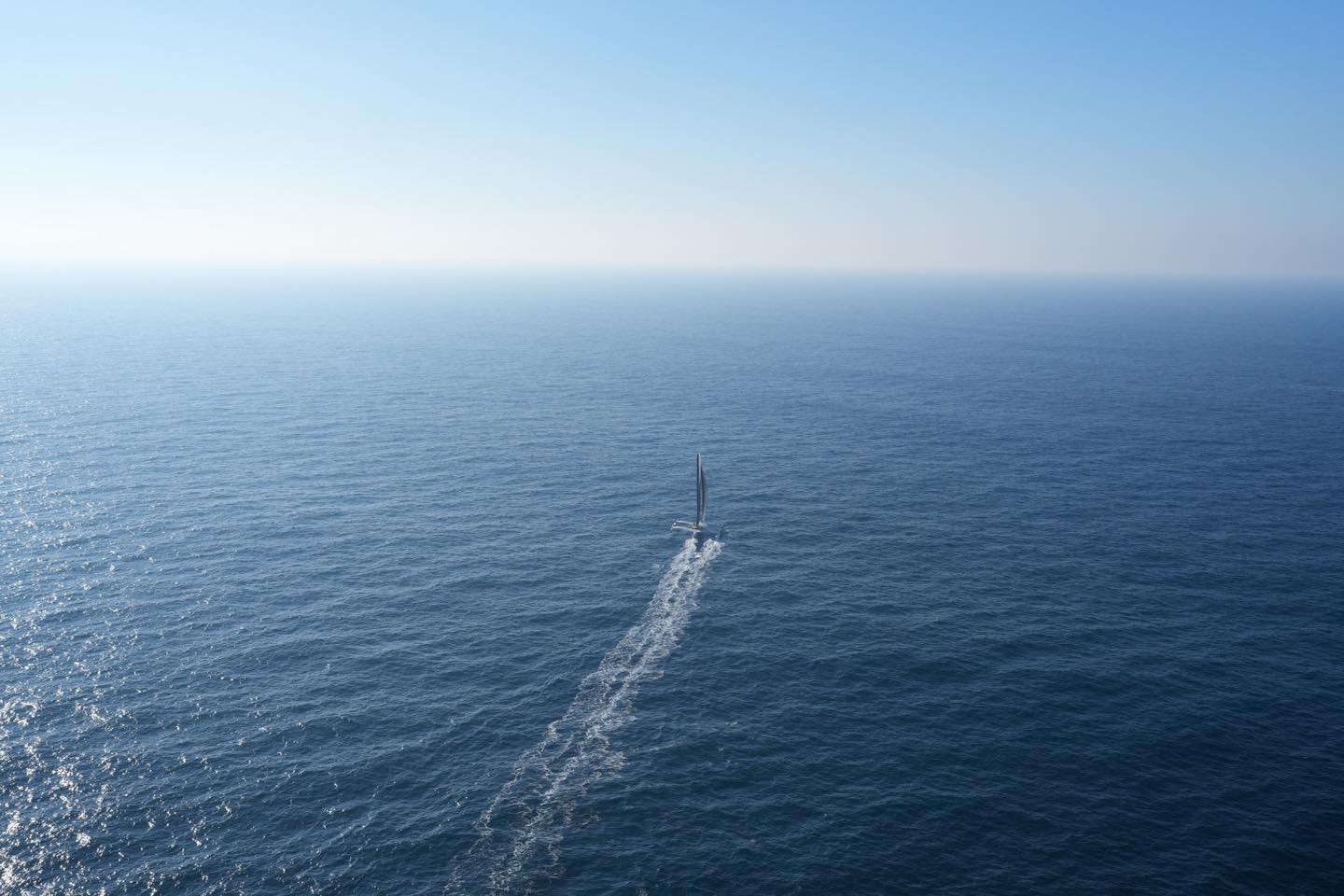
Jules Verne Trophy: the Maxi Edmond de Rothschild makes for the start line
Charles Caudrelier, Franck Cammas and their crew left the port of Lorient at daybreak this Sunday 12 February to make for the Jules Verne Trophy start line offshore of the island of Ushant. On standby since late December, the men of the Maxi Edmond de Rothschild have decided to try their luck, despite the rather atypical weather window. Gitana Team is preparing to take on an almighty challenge: to beat the famous record set by IDEC (2017) in 40 days, 23 hours and 30 minutes. Always an exciting and emotional moment, the passage across the line is scheduled for midday this Sunday. The timing will be tweaked during the delivery trip to Ushant in consultation with Marcel van Triest, router for the five-arrow team.
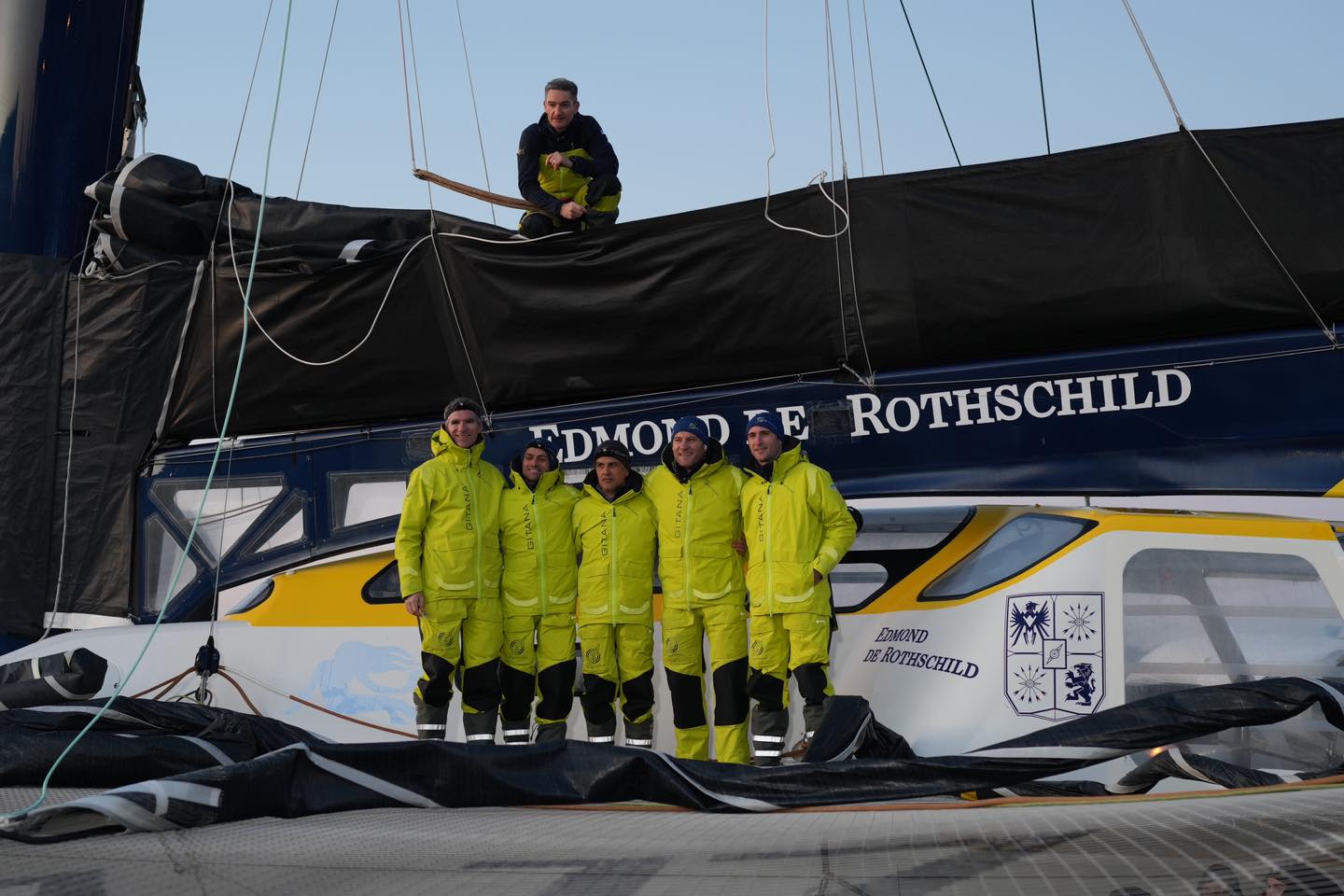
It’s the start of a great adventure and so begins at last an oceanic race against the clock and one of the most thrilling challenges on the sailing planet. Charles Caudrelier and Franck Cammas, two of the most experienced sailors in the discipline, together with their four crew, are preparing to make a bid for the Jules Verne Trophy, the outright record for circumnavigating the globe under sail, unassisted and without stopovers.
Gambling on a unique weather window
The build-up to this moment has required a great deal of patience, a careful study of the evolution of conditions and the hunt for a favourable weather sequence between the North Atlantic and the South Atlantic. The standby commenced on 22 December 2022, just weeks after Charles Caudrelier’s victory in the Route du Rhum – Destination Guadeloupe. Since Friday, the meetings between the men of Gitana Team and their router, Marcel van Triest have been steadily increasing. Indeed, a window has opened up for the team to set sail from the north-west tip of Brittany, though it’s not an obvious one. Having deliberated for quite some time – the option looking less pertinent on Saturday morning – the situation turned around again in the hours leading up to the Maxi Edmond de Rothschild’s departure this Sunday morning from her port of registry in Lorient.
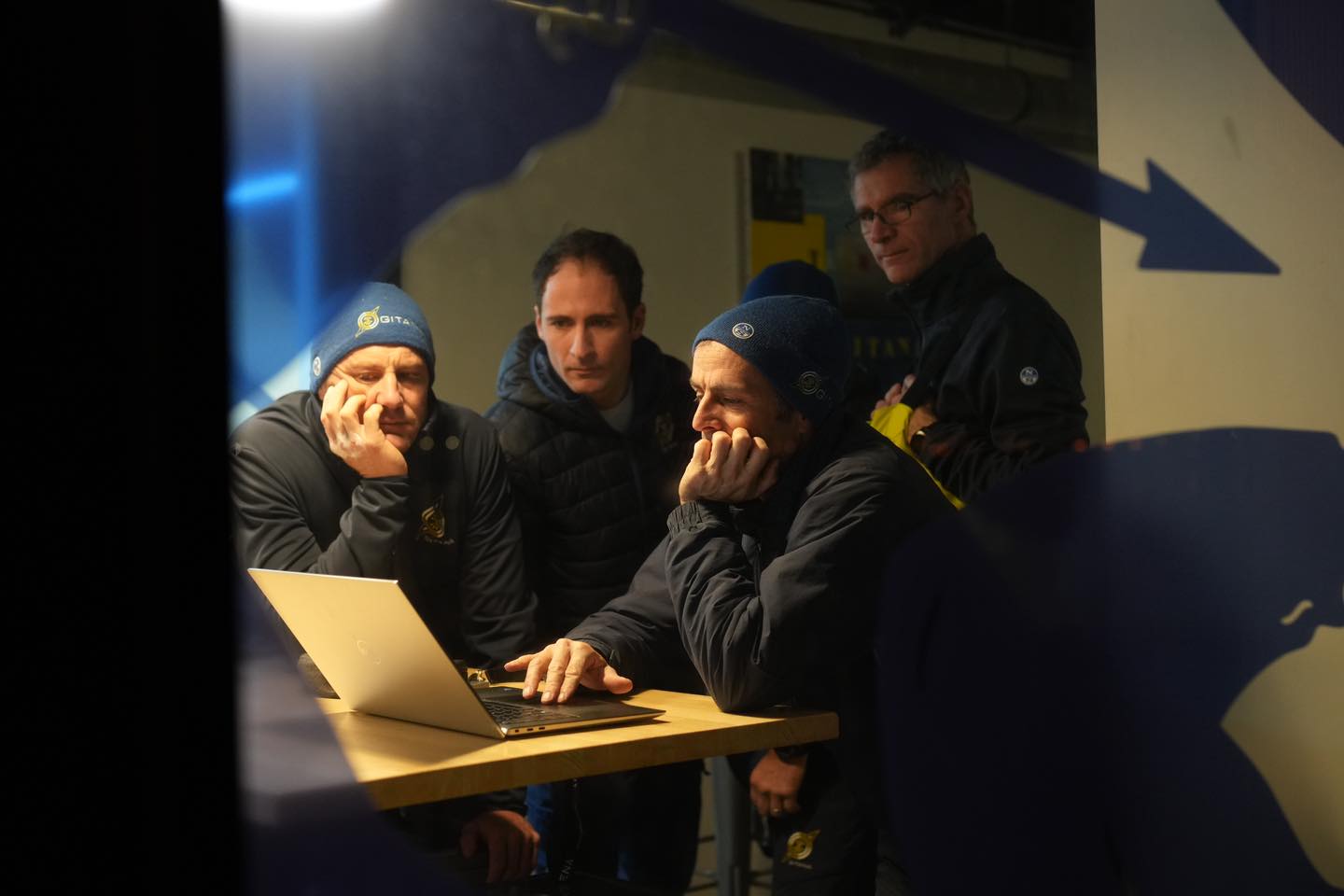
There’s no doubt that it’s a big gamble for the team, particularly in light of the atypical weather window. “It’s nigh on impossible to have the perfect scenario in any case,” Charles Caudrelier has admitted many times over recent weeks. Though the North Atlantic looks very favourable, the gateway into the South is not so obvious. Everyone knows that the team will need to give it their all, plus they’ll need an element of luck and success to facilitate their passage offshore.
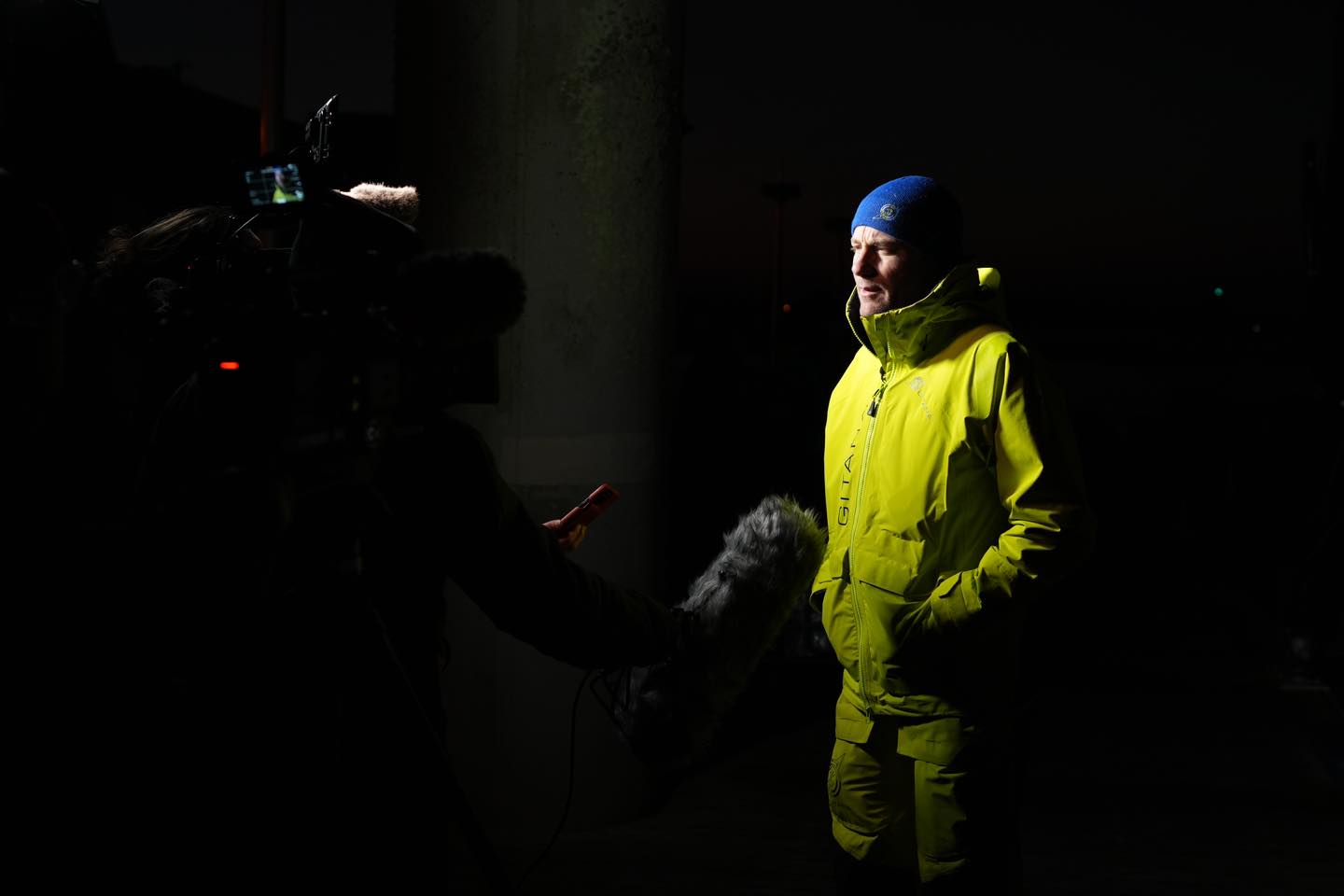
Such are the intricacies of trying to establish a new record and the whole crew was well aware of this when casting off from the dock in Lorient this Sunday morning. Hearts were racing, faces became a little more intense and the ambiance was a mixture of excitement and heightened concentration. Indeed, at the end of this adventure, which will require everyone to give their best, there is an opportunity to rewrite history. On everyone’s minds is the previous record, set in 2017 by Francis Joyon and his men following an exceptional sequence of weather conditions: 40 days, 23 hours and 30 minutes.
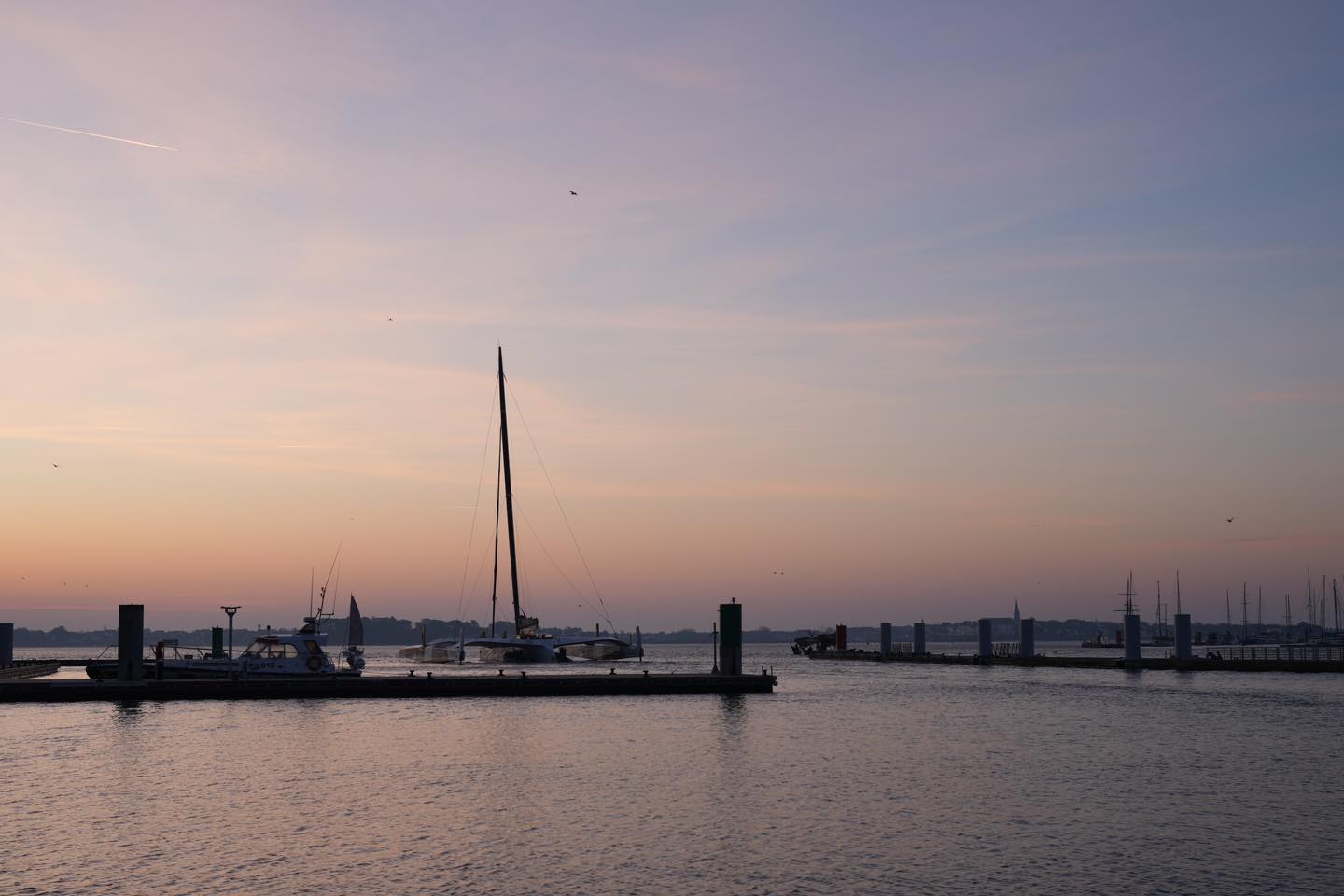
Yann Guichard : “Why I wanted to start…”
The Sails of Change crew had been watching for the weather window that opened today (Saturday 14 Jan) in the North Atlantic since the middle of last week. Yann Guichard was keen to seize what would have been the first opportunity for a start since the maxi trimaran went on standby last October, even though it was packed with uncertainty.

Yann Guichard, how would you describe the weather window that up until today looked promising?
“It was excellent as far as the Equator – the router had us there in just over five days. But after that there was no favourable low-pressure system to link up with the trade winds and reach the Cape of Good Hope inside 13 days, which is not a good time. This was the first opportunity for a start since we went on standby, but it was far from perfect. We studied the files again late last night alongside the overall forecast* that came in at around 23:00 before our router Jean-Yves Bernot, our navigator, Benjamin Schwartz, and I made a decision.”
In your heart of hearts, did you think you should start?
“I really wanted to leave today, just behind the front which passed through at around 14:00, so in the middle of the afternoon. But it’s a very difficult decision to make. Postpone for better weather in the southern hemisphere and the Bay of Biscay becomes impassable due to the sea state until next Wednesday. And on Wednesday, the window in the North Atlantic shortens and may very well close again. We are already mid-January with a month of standby left. It is a double-edged sword, interesting and challenging!”
Yann Guichard and the 10 Sails of Change crew members remain fully focused on the evolution of the weather window.
‘Blocking patterns’ – explained!
‘Code red’ has been trending for Yann Guichard and Dona Bertarelli’s team onboard the maxi-trimaran Sails of Change since they went on stand-by on 24 October last year. Jean-Yves Bernot, the shore-based router, throws some light on what has been an unprecedented weather situation.
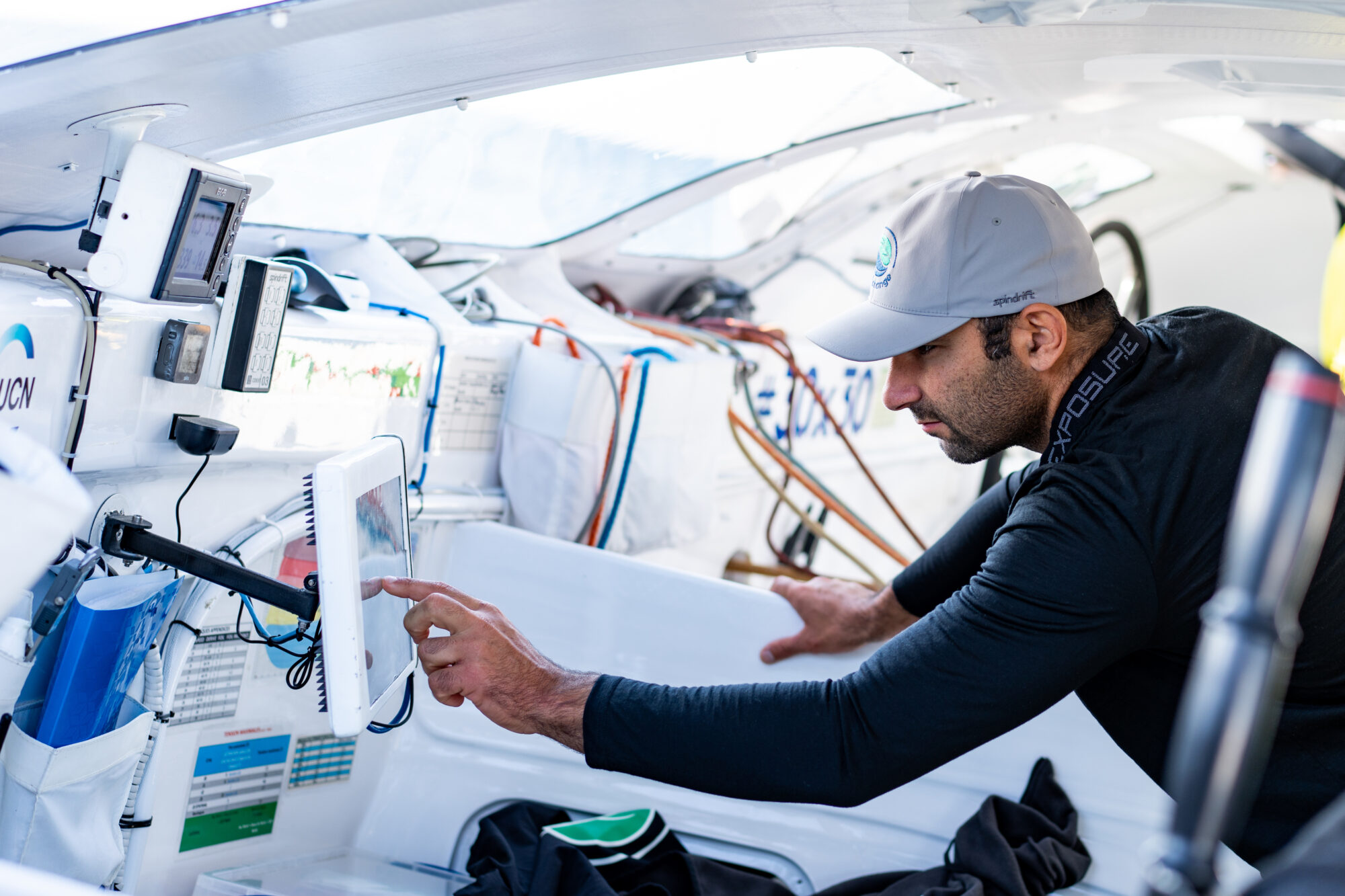
The team – on its fourth Jules Verne Trophy record attempt – moored the trimaran in Brest on 10 November to be able to respond quickly to a weather window and subsequent code change, and there it has remained, tugging on its lines. ‘Rouge sur rouge, rien ne bouge’ goes the adage, loosely translated as ‘Red over red, no movement ahead’. The stand-by code has not changed colour since last autumn.
“Last year, we didn’t start although certain scenarios could have been tempting, even though the subsequent transitions were not promising. This year, there has not been one day that left room for doubt,” said Jean-Yves.
Overall, there are two scenarios that are favourable for a Jules Verne Trophy record attempt : setting off on the tail-end of an Atlantic low pressure, using the north-westerly shift to head south in strong downwind conditions. Or setting off on the back of a winter high pressure system stuck over Europe, synonymous with favourable easterly wind conditions. “This year, the low pressures haven’t shown any clear shifts with the wind remaining in the South-West,” explained Jean-Yves. “And when the cold snap hit France at the beginning of December, the anticyclone was positioned in such a way that it blocked the route to the Moroccan coast. Most importantly, these weather patterns have been long-lasting. In meteorology, we call them blocking patterns.”
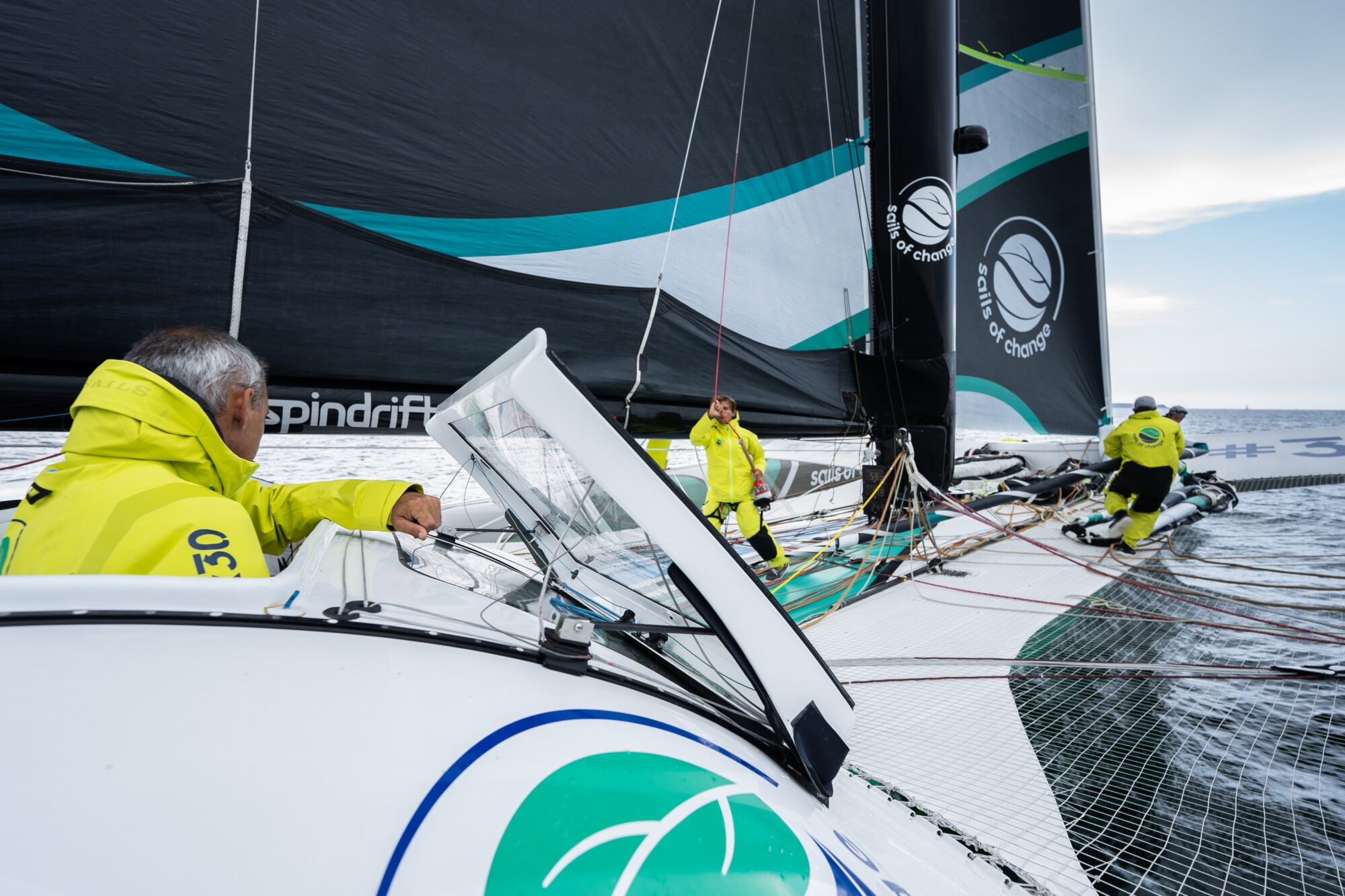
To have a hope of breaking the record set by IDEC Sport (40 days, 23 hours, 30 minutes), the team knows that it must be very punchy at the start of the Atlantic phase, and then nail all the transitions until they get down to the first of the southern lows. “IDEC Sport made great time in the Indian Ocean, had a decent Pacific experience, and an excellent finish,” continued Jean-Yves. “The section that can really be improved on timewise, is the Atlantic. If you are two days late to the Cape of Good Hope, you’re done, game over. We have run 2,000 simulations, and four of them went through to the finish!”
In short, there is no point in setting out to tackle such a demanding record with the only certainty being a very unfavourable start. The question is how long does the Sails of Change team wait? While there is no cut-off date currently in place, ultimately the cycle of the seasons will dictate. Putting aside the fact that the nights will get longer in the high latitudes from February onwards, the Sails of Change router warns of the dangers of the Southern Ocean in the southern hemisphere’s autumn months. “It’s like comparing the situation at home between the end of September and the end of October, it’s not the same atmosphere at all. In the South, from mid-February onwards, the winds are so strong that you can’t sail a multihull at its optimal speed anyway.”
A few weeks remain in this complex waiting game, the outcome of which ultimately lies with Mother Nature. Yann Guichard, owner and skipper of the maxi-trimaran Sails of Change explains : “The stand-by of the maxi Sails of Change is planned until the 15th of February, date beyond which it is more complex to leave because of the end of the summer and the systems of depression in the Great South. We have a window of a little more than a month ahead of us, we remain very optimistic because the situation can change.”
Around the world record attempt : the Maxi-trimaran Sails of Change arrives in Brest and remains on stand-by
The Maxi-trimaran Sails of Change, on stand-by since October 24, 2022, for a new attempt on the round the world sailing race, the Jules Verne Trophy, arrived in Brest today. The delivery trip from La Trinité-sur-Mer went smoothly in a moderate southerly wind. Now based near Ushant, the boat and crew are waiting for a favourable weather window that will allow them to reach the Cape of Good Hope in around twelve days.
Yann Guichard and his crew have attempted this record three times: in 2015 (47 days, 10 hours, and 59 minutes) with Dona Bertarelli, who became the fastest woman around the world, in 2018, and in 2019 when they were forced to retire due to rudder damage just past the Kerguelen archipelago. The Jules Verne Trophy record was further reduced in 2017 when IDEC Sport completed the circumnavigation of the globe in 40 days 23 hours 30 minutes and 30 seconds. The round-the-world record has become increasingly difficult to improve on with each successive attempt (over thirty in less than thirty years!): Early attempts started in the North Atlantic in a storm. Nowadays, it is thought to be better to ride on the back of a high-pressure system. Back in 2010, the aim was to reach the equator in less than a week, whereas today, the objective is to reach the Cape of Good Hope in around twelve days!
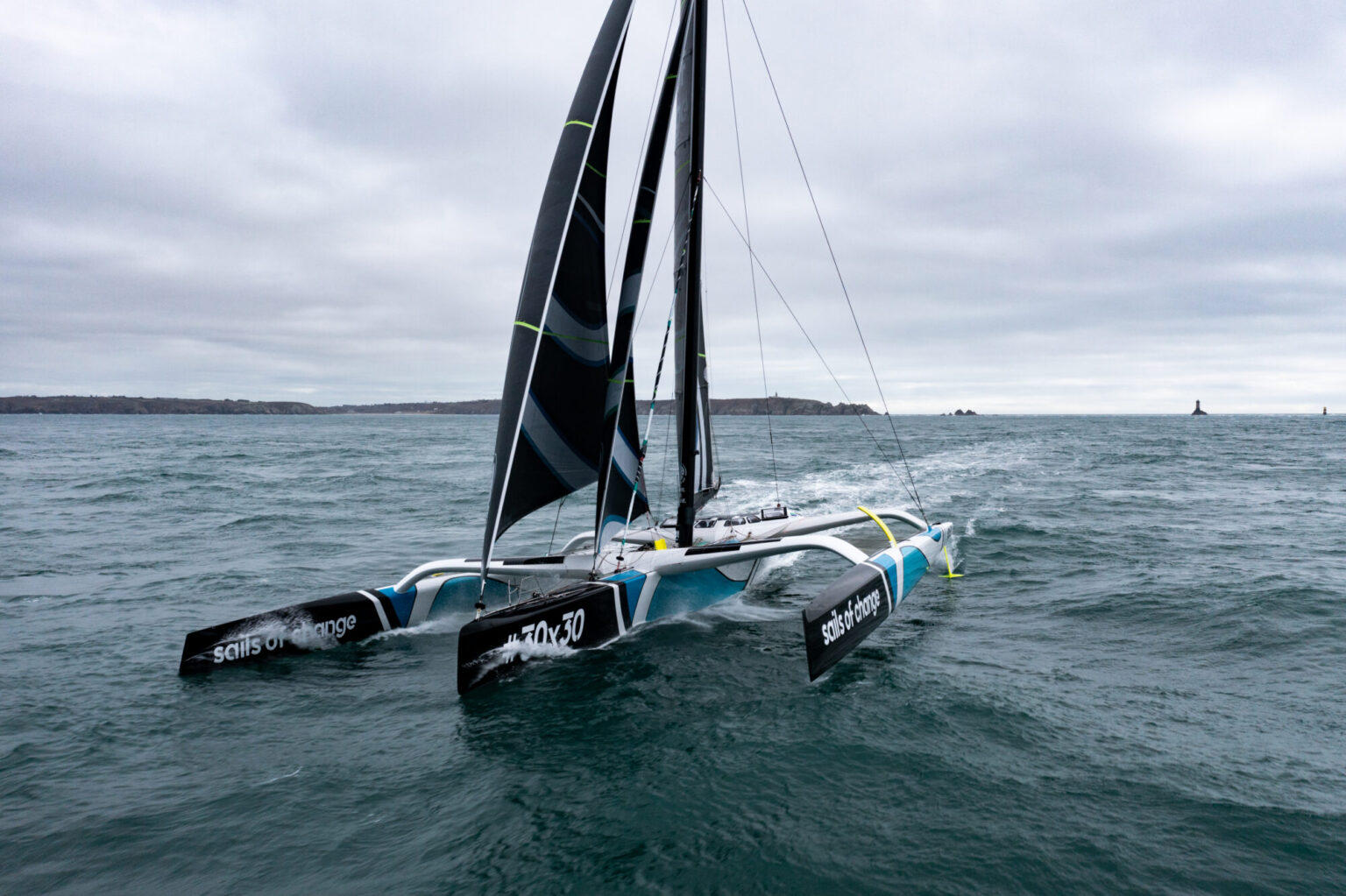
A LAP OF THE PLANET IN STAGES
The course is made up of stages, the shortest possible direct route is a minimum of 21,600 nautical miles, but no sailing boat can follow this because of the prevailing winds. First you must cross the Atlantic from North to South across the equator, the first milestone of the Around the World (Jules Verne Trophy). To reach the Cape of Good Hope in less than twelve days means setting off in a Northerly wind, linking up with the Portuguese trade winds, and crossing the dividing line between the two hemispheres in less than five and a half day. Following that you need to round the St. Helena High and transition from a South Easterly to a North Easterly before reaching the Roaring Forties in the Southern Ocean. Then you head into the Indian Ocean. An optimal Atlantic passage is key to breaking the record. Sails of Change (ex-Spindrift 2) already holds the best time between Ushant and the equator achieved on the third attempt at the beginning of 2019 (4 days, 20 hours, and 07 minutes). But it is the sequence of events in the South Atlantic that will determine whether the reference time at the Cape of Good Hope can be achieved to enter the Indian Ocean ahead of the record. It will then take around six days to reach southern Tasmania, and another eight days to reach Cape Horn.
Once there, it’s far from over! The team must then sail north up the Atlantic Ocean, preferably along the Argentinean coast (which can take at least a week), and across the equator for a final sprint to Ushant (around six days). If you add up the various best times achieved per stage, it totals 38 days, 16 hours, 36 minutes. Therefore, the decision of when to start is pivotal.
A SPECIAL KIND OF LOGIC
“IDEC had some pretty brilliant conditions in the Indian Ocean and on the way up the Atlantic. So, we must have a lead when we reach the Cape of Good Hope because it will be hard to make up time elsewhere. There is a way to gain time on the southbound Atlantic stage and during the Pacific crossing, but that’s it. So, we must improve on the times that have been set by going down to South Africa and the Pacific faster. For the rest, to achieve the same times as the record holder would be quite good. For the moment and for the next few days until mid-November, there is no weather window for a start, because the trade winds are weak or non-existent and the Southerly wind is set over Western Europe”; said Jean-Yves Bernot, shore-based router for Sails of Change.
“There are no openings for now in the North Atlantic because the trade winds are not really settled : we have to be patient. Remember that IDEC left quite late! And it’s preferable to be on stand-by in Brest because we gain about half a day of weather forecasting”; added Benjamin Schwartz, navigator on Sails of Change.
This round-the-world record, which has decreased from 79 days, 06 hours, 15 mins, and 56 secs (Commodore Explorer in 1993) to just 40 days, 23 hours, 30 mins, and 30 secs in a quarter of a century, has for the most part required two or more attempts to break.
AROUND THE WORLD: A NEW ATTEMPT BY THE MAXI TRIMARAN SAILS OF CHANGE
Yann Guichard, Dona Bertarelli and nine other sailors will make up the crew of ‘Sails of Change’ for their next attempt on the Jules Verne Trophy, an award for the fastest non-stop and unassisted circumnavigation of the world. Several years of hard work will culminate in this ultimate sporting challenge. The crew also aims to raise awareness of the need to preserve ocean and land ecosystems. From October 24th, the team will be on standby, ready to set sail on a new adventure.
From Monday, October 24th, the crew of Sails of Change will be on standby, studying the weather conditions and gearing themselves for an immense challenge. The objective is to win the Jules Verne Trophy by beating the round-the-world record held since 2017: 40 days, 23 hours, and 30 minutes. “It’s the ultimate sporting goal, an extraordinary time to beat, that has been halved in the space of 30 years“, said skipper Yann Guichard.
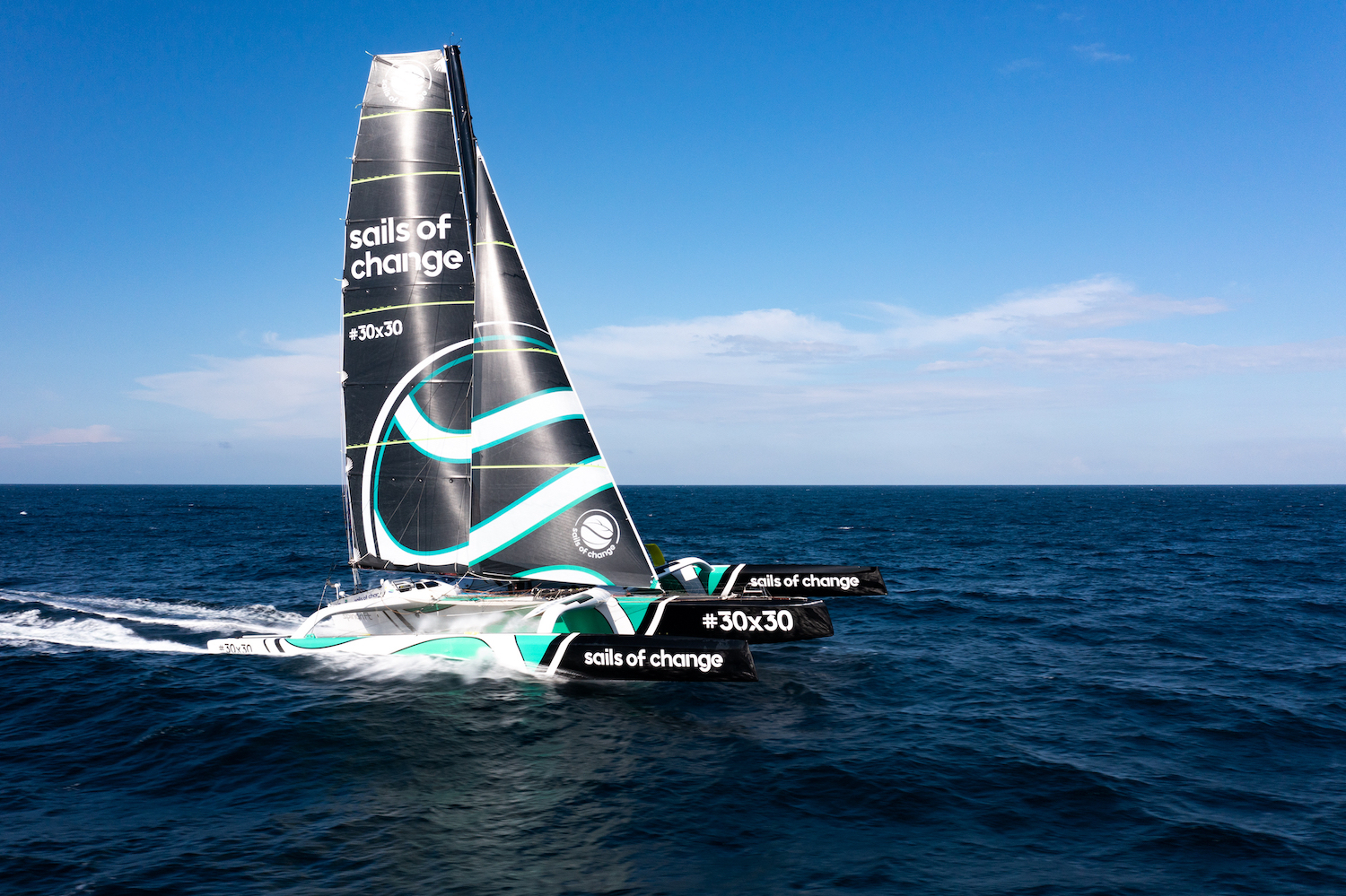
A TEAM ON THE RISE
The Spindrift team has been hard at work throughout 2022. The team participated in all six events of the TF35 Trophy, an annual championship which combines sea and lake races across Europe. Spindrift ended the season in 3rd place overall.
The maxi trimaran has also sailed on multiple occasions. “There are still a few adjustments to be made, but the boat is ready,” said Yann Guichard. “I can feel the team is eager to go.”
Once standby begins, the maxi trimaran, based at La Trinité-sur-Mer, will be ready to set off for Brest at the first favourable weather window.
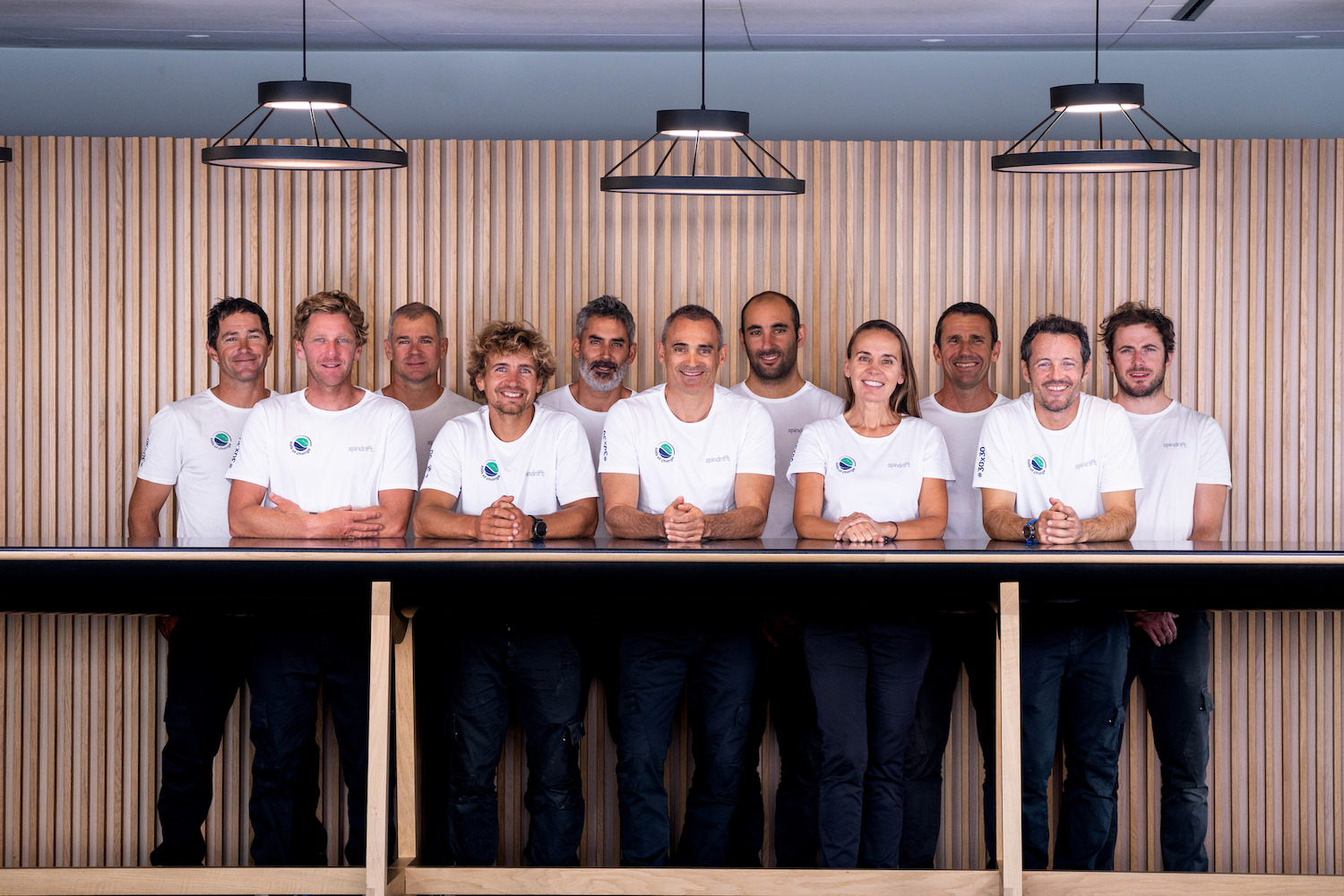
A TEAM OF LIKE-MINDED ENTHUSIASTS
Joining Yann Guichard and Dona Bertarelli, the onboard reporter, will be nine crew members. “Some have been part of the project for years and others have joined us this year,” said the skipper. “We have an experienced team who enjoy competing and who are ocean enthusiasts. We share the same appreciation of effort and solidarity”.
THE CREW PRESENTED BY YANN GUICHARD:
Dona Bertarelli (54 years old): “I’m delighted to share this new adventure with Dona, who participated in our first round-the-world trip in 2015-2016. Her presence will bring added purpose to a great sporting challenge.”
Thierry Chabagny (50): “An experienced sailor who has already sailed twice around the world. His experience will be invaluable.“
Grégory Gendron (39): “Joined our team in 2019. Greg is always smiling, friendly, and ready to help. He is very comfortable sailing at sea, I have total confidence in him.”
Clément Giraud (41): “He just finished the Vendée Globe and is one of our Southerners. He is full of the joys of life.”
Jacques Guichard (42): “Watch-leader, I’ve been able to count on his multiple talents since the birth of the Spindrift project. Sharing this adventure with my brother is such a blessing and will bring us even closer together. “
Pierre Leboucher (41): “A newcomer to the crew but with solid experience, having sailed in the Olympics and Le Figaro. Pierre is a true sailor who likes to push himself to the limits.”
Christopher Pratt (41): “He also joined us this year. He is a Cartesian spirit: structured and focused on performance. If he does something, he does it 100%.”
Xavier Revil (51): “A great sailor and former holder of the Jules Verne Trophy. I’ve known Xavier since my Optimist years; he’s been with us since the start of the Spindrift adventure. As a watch captain, I know I can rely on his know-how at all times.”
Benjamin Schwartz (36): “He has sailed in Le Figaro and has sailed round the world in the Volvo Ocean Race. Responsible for the navigation unit, I can count on his detailed analysis of weather strategy.”
Julien Villion (30 years old): “With solid experience from Le Figaro, he is always seeking the right settings and constantly questioning himself, raising our overall performance. “
Jean-Yves Bernot (router): “A recognised specialist, he has been by our side since our first round-the-world attempt in 2015. As both a former navigator and a land router, he knows the course like no one else. He’ll be our guardian angel during this new attempt.”
SAILS OF CHANGE, AN EXTRAODINARY TRIMARAN
A multihull built to perform. 37 metres long, 23 metres wide and weighing 21 tons, Sails of Change is the largest ocean racing trimaran ever built, and has a track record to match. Launched in 2008, the boat held the Jules Verne Trophy from 2012 to 2017 (45 days, 13 hours). Sails of Change was acquired by the Spindrift team in 2013, winning the Route de la Découverte (between Cadiz and San Salvador), and performing well in the Rolex Fastnet Race (twice), and in the 2016 Transat Québec – Saint-Malo.
In 2014, sailing this giant boat solo, Yann Guichard achieved second place in the Route du Rhum, a remarkable sporting and human feat.
SEEKING THE RECORD WITHOUT USING FOSSIL FUEL
“Sails of Change is more than a human and sporting adventure,” said Yann Guichard. “We wanted our philanthropic activity and our deep, personal goals of protecting the planet to inform the Spindrift programme. Dona was already raising awareness of this theme during our first attempt in 2015.”
“For 20 years, I’ve been working to create large marine protected areas, and to safeguard biodiversity,” added Dona Bertarelli. “The connection between ocean preservation, the climate, and human health is no longer in doubt.”
“Since 2021, Spindrift teams have been preparing a round-the-world attempt without using fossil fuels, a ‘challenge within the challenge’ according to Yann. There will be no combustion engine onboard, which traditionally powers a boats’ electronics, communications, desalination, and water heating. “To compensate, we have solar panels, two wind turbines and a methanol fuel cell,” said Yann.
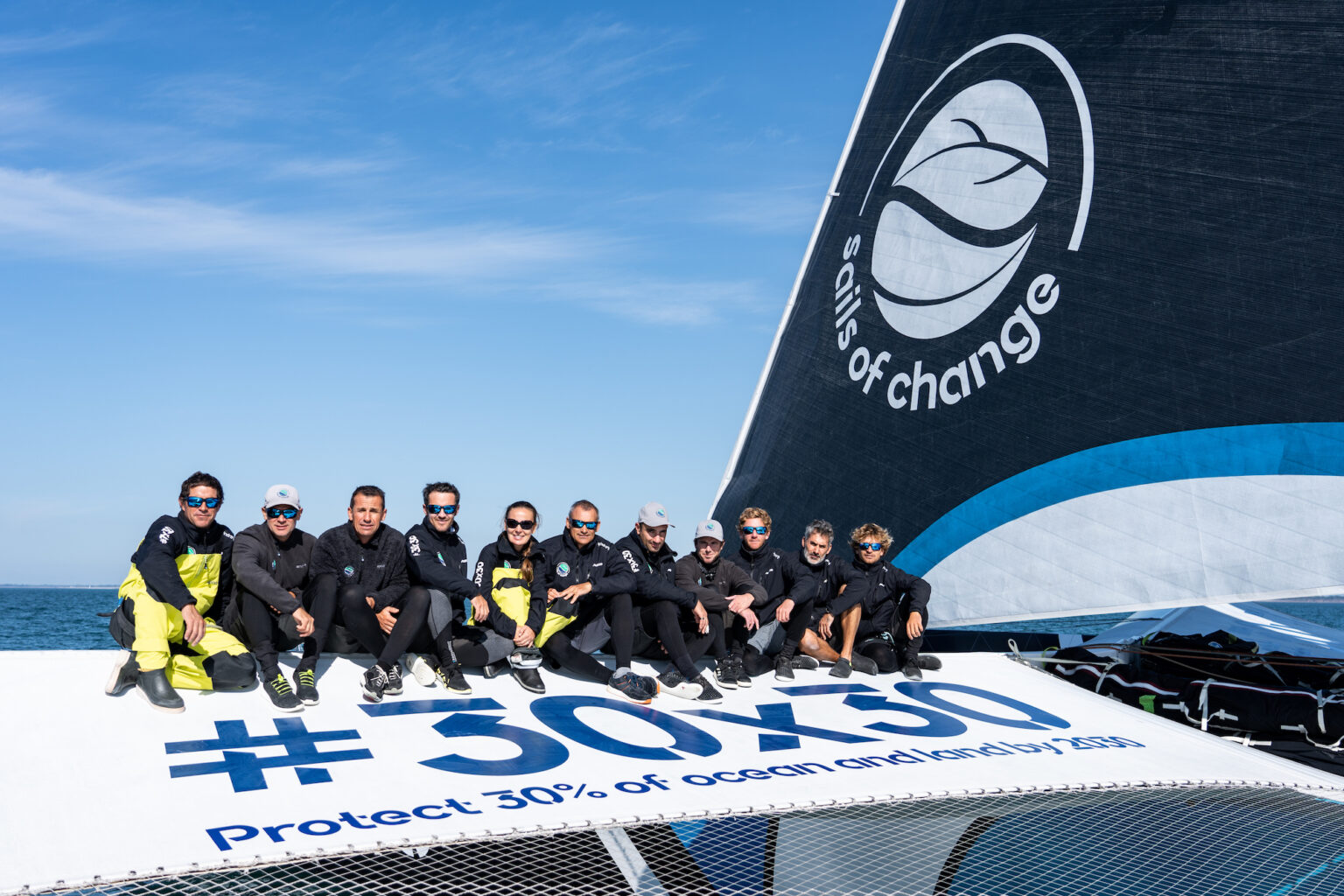
A 360° COMMITMENT, A “NEW IMPETUS”
The Spindrift team’s commitment to protecting the environment does not stop with the boat. The crew, as well as the boat, promote the ’30×30′ message, relaying the call from scientists to protect at least 30% of ocean and land by 2030, in order to prevent biodiversity loss and to build resilience to climate change. “The degradation of our oceans, land and freshwater systems is destroying the planet’s ability to support life,” said Dona Bertarelli. “The fight to protect nature, which we’ve been engaged in for a long time, gives extra impetus to the team and to our round-the-world challenge.”
Dona and Yann are Patrons of the International Union for Conservation of Nature (IUCN), the largest and most diverse environmental network in the world, and a global authority on the state of the natural world and the measures needed to save it.
A new partnership between IUCN and Sails of Change called “Sports for Nature” was launched at the Sport Positive Summit at Wembley on 5 October, to help sports organisations mitigate the negative impacts on the climate, and to take concrete steps to protect biodiversity. “As a sportsperson, the link between sports and nature is very clear. Athletes need clean water and fresh air to perform. As such, they have a natural interest in protecting the environment,” said Yann Guichard.
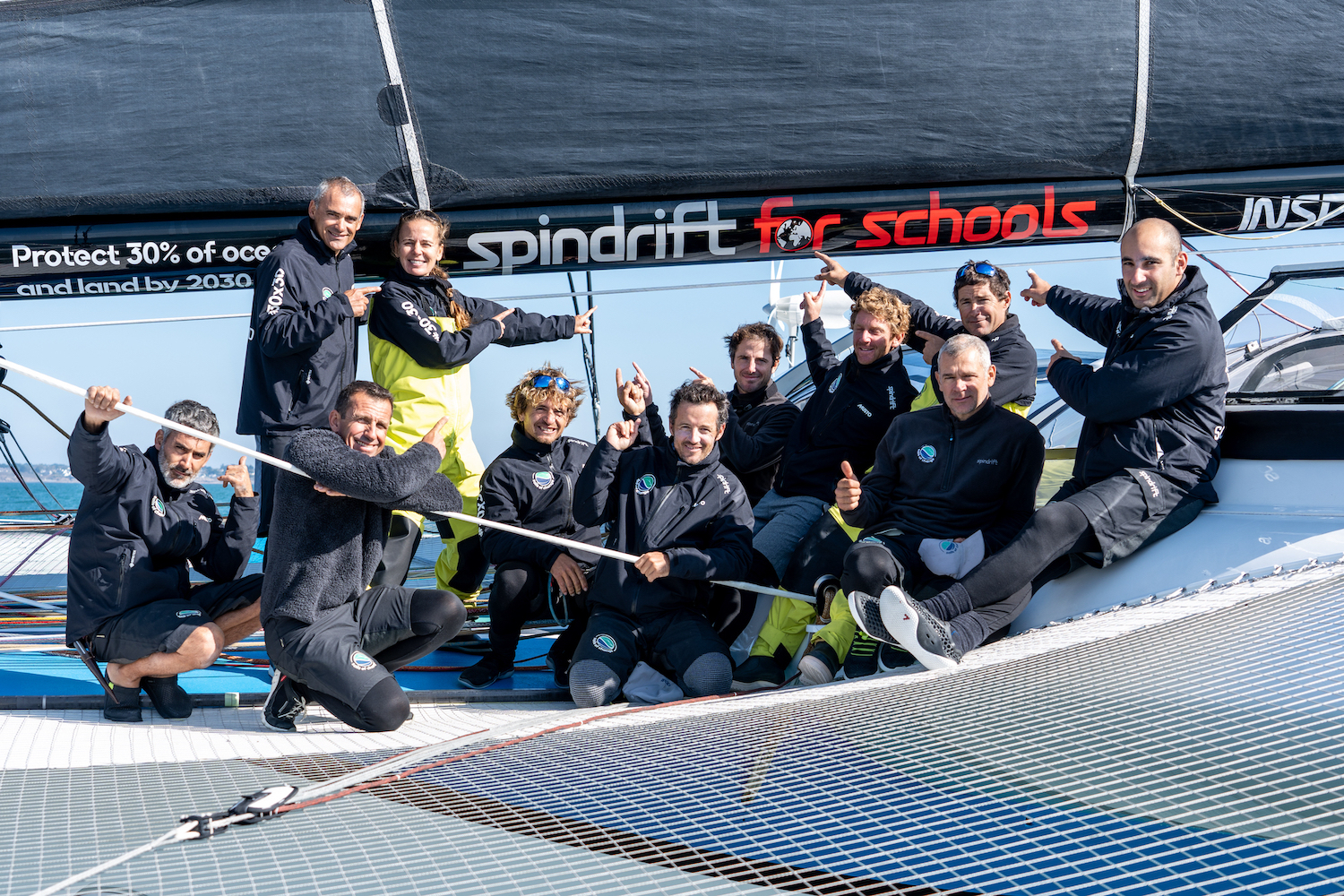
SPINDRIFT FOR SCHOOLS: INSPIRING AND EDUCATING THE YOUNGER GENERATION
The ‘Spindrift for Schools’ fund was created in 2014 to raise awareness of environmental issues among young people. Through this fund, educational resources, approved by the French Ministry of Education and supported by UNESCO, are made available to teachers. Additional subjects will be offered to schools as part of the curriculum throughout the world tour in order to bring onboard the youngest in this global ocean adventure.
For students as well as for sportsmen and women or even the curious, this will help them to grasp the intensity of this round the world trip from a perspective that shares the ‘Sails of Change’ values. Dona Bertarelli insists on “learning from nature in order to act”, “uniting to inspire change” and “keeping a sense of wonder because it is easier to protect what you know, what you understand and what you love“.
For Yann Guichard, he makes the link with life onboard and evokes “the need to surpass oneself, to show resilience and support each other at all times“. There are so many arguments and motivations before setting off on one of the most exciting challenges in ocean racing.
Dona Bertarelli and Yann Guichard announce the end of standby for the maxi-trimaran Sails of Change for the Jules Verne Trophy and plan a fresh attempt.
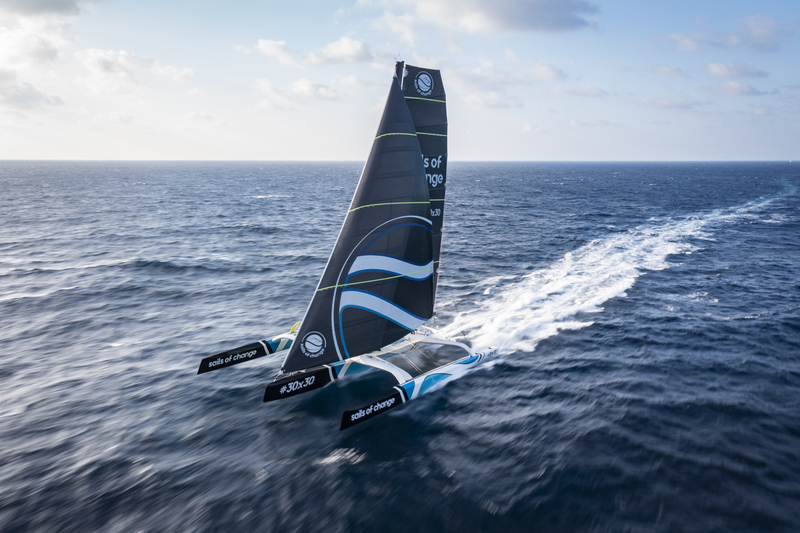
On November 1st, 2021, Dona Bertarelli, Yann Guichard and their team began the standby for a fourth attempt at the Jules Verne Trophy around-the-world sailing record. Since this date, there has not been a suitable weather window for the crew of the maxi-trimaran Sails of Change to set sail with a realistic chance of beating the record. Today, Dona Bertarelli and Yann Guichard announce the end of standby for Spindrift and their plans to renew the attempt later this year.
A complex weather scenario
To beat the around-the-world record under sail, it is key to maximise the team’s chances during the first section of the route. The primary challenge for the maxi-trimaran Sails of Change is to make a very fast passage from the island of Ushant to the equator (within the record time of 4 days 19 hours and 57 minutes set by Spindrift herself in 2019). The crew would then need to make the southern tip of Africa in under 12 days, to be level with the previous record. With this in mind, since November 1st, 2021, Yann Guichard (skipper), Benjamin Schwartz (navigator) and Jean-Yves Bernot (onshore router) have been analysing the weather in a bid to pinpoint the perfect configuration for linking these two sequences together. However, over the winter, the weather scenario has not once been favourable for starting the attempt.
Jean-Yves Bernot explains: “For some weeks, the low-pressure systems rolling towards Europe have been positioned a long way south, around the Canaries, Madeira and to the south of the Azores. Such a weather configuration prevents the trade wind from being strong and becoming established longer term. Usually, such episodes are fleeting, only lasting a few days at best. However, this year, the cycle has been on constant repeat. This has resulted in large areas of light breeze from the south of Gibraltar as far as Cape Verde. Of course, this is not at all conducive for setting sail on a round the world record. At the same time, in the South Atlantic, the Saint Helena High was extensive at the start of standby, making it difficult to negotiate due to the numerous windless areas. For Sails of Change, there was a very real risk of getting stuck there”.
In light of this situation, at the beginning of January, the team decided to extend the period of standby by two weeks until January 31st. During this time, the weather situation has remained unchanged and the forecasts for early February are not optimistic.
Jean-Yves Bernot also points out that a late entry into the Deep South is not recommended: “The austral summer is gradually drawing to a close. Sailing conditions in this area are becoming increasingly complicated with the cold, the gales and very heavy seas. With too much bad weather comes the increased risk of suffering damage, and it is more difficult to maintain the high average speeds needed to break the record”.
Within this context, Dona Bertarelli and Yann Guichard have decided to call off their team’s standby for the Jules Verne Trophy record.
A fresh attempt in the winter of 2022/2023
Yann Guichard, skipper of the Spindrift racing stable, considers today’s situation: “For the past two years, the team has done a remarkable job optimising our maxi-trimaran Sails of Change. The boat has never been so well prepared to break this record and that’s something we can be proud of. Of course, it’s disappointing not to be setting sail. We switched to code green twice, but unfortunately the weather windows promptly closed up again. The routing subsequently confirmed that we’d made the right decision not to leave, so we have no regrets. I greatly appreciate that the entire team has been mobilised and at the ready for the last three months, especially the sailors, who remained their high levels of motivation. We’re lucky to have a fantastic team and a boat which is designed for the Jules Verne Trophy. This is why Dona and I are delighted to announce that Spindrift racing stable will be back on standby for another attempt at the around-the-world record at the end of this year”.
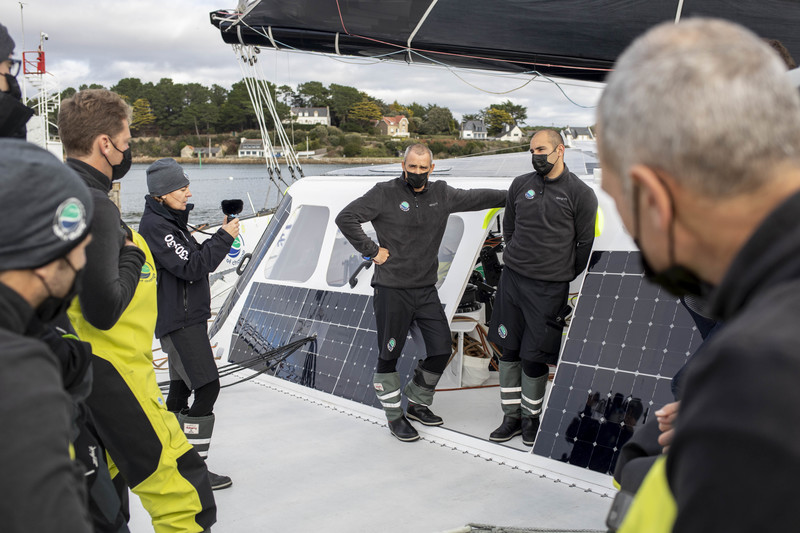
Dona Bertarelli adds: “We are about to unveil the sports programme for our team for the year ahead. Through our various projects, we’re keen to continue being the standard-bearer for the “30×30” campaign, which aims to protect 30% of our planet by 2030. Our aim is to raise awareness among the general public and institutions to promote the additional commitments which governments around the world need to make. At the same time, we’re extending our efforts with students through our “Spindrift for Schools” programme, which aims to raise awareness among young people”.

2021/2022 crew:
Yann Guichard – Skipper
Dona Bertarelli – On-board reporter
Benjamin Schwartz – Navigator
Jacques Guichard – Watch leader
Xavier Revil – Watch leader
Duncan Späth – Helm / trimmer
Grégory Gendron – Helm / trimmer
Julien Villion – Helm / trimmer
Thiery Chabagny – Helm / trimmer
Jackson Bouttell – Bowman
Yann Jauvin – Bowman
Jean-Yves Bernot – Onshore router

